Wakefield, West Riding of Yorkshire
Up to 1834
Wakefield had several early poorhouses. The first, combined with a House of Correction, was built in 1689. Another at Horbury was in operation by 1747. By 1834, Wakefield had a parish workhouse on George (or Georges) Street at the top of Thornhill Street, opposite Crowther's Almshouses.
East Ardsley's parish workhouse was located at the north-east of the village near where the modern-day community centre now stands.
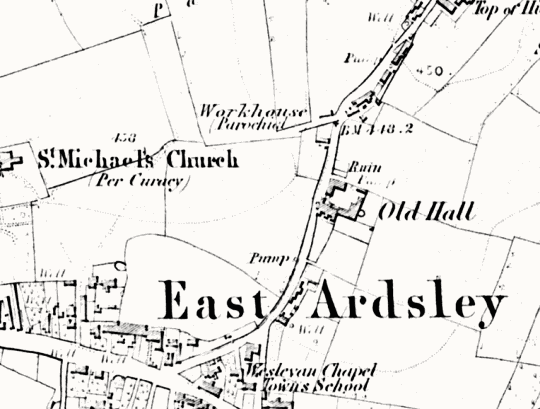
East Ardsley workhouse site, 1855.
By 1776, Alverthorpe-with-Thornes had a workhouse off Light Lane, while Emley had a workhouse fromn 1803 to 1835 on Out Lane.
The parish workhouse in Stanley presumably stood in the vicinity of the row of cottages marked as "Workhouse Fold" on the 1855 map below. Modern housing now occupies the site.
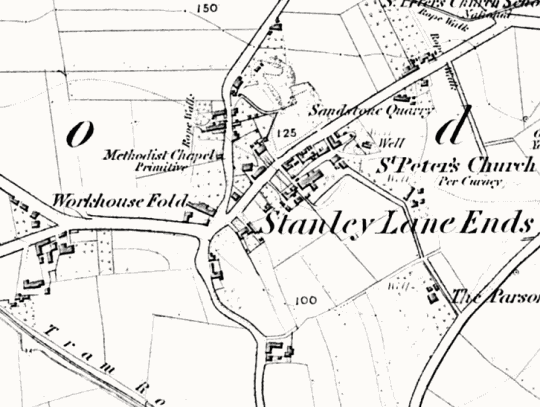
Stanley workhouse site, 1855.
A parliamentary report in 1834 recorded the workhouse populations in a number of Wakefield townships:
| Workhouse | Inmates |
|---|---|
| Alverthorpe and Thornes | 11 males aged 7 to 79 years, 10 females aged 7 to 65. |
| Stanley | Total 36: 11 men, 14 women, 6 boys, 4 girls, and a matron. |
| Wakefield | 37 males and 37 females |
After 1834
Wakefield Poor Law Union was formed on 10th February 1837. Its operation was overseen by an elected Board of Guardians, 22 in number, representing its 17 constituent parishes as listed below (figures in brackets indicate numbers of Guardians if more than one):
West Riding:
Alverthorpe and Thornes (2), East Ardsley, West Ardsley, West Bretton, Crigglestone, Emley, Flockton, Horbury, Oulton with Woodlesford, Sandall [Sandal] Magna, Sharleston [Sharlston], Shitlington, Stanley with Wrenthorpe (2), Thorp [Thorpe], Wakefield (4), Walton, Warmfield-cum-Heath.
Later Additions: Altofts (from 1869), Chevet (from 1850), Crofton (from 1869), Norton Within (1901-1904), Lofthouse with Carleton (from 1861), Newland with Woodhouse Moor (from 1858), Normanton (from 1869). Oulton with Woodlesford transferred to the Hunslet Union in 1869.
The population falling within the Union at the 1831 census had been 37,032 — with parishes ranging in size from Thorp (population 62) to Wakefield itself (12,232).
Like many other areas of Yorkshire, Wakefield fought against the principle of large mixed workhouse. The new Board of Guardians retained the George Street workhouse which was rented at a cost of £60 a year. Its location and layout are shown on the 1848 map below.
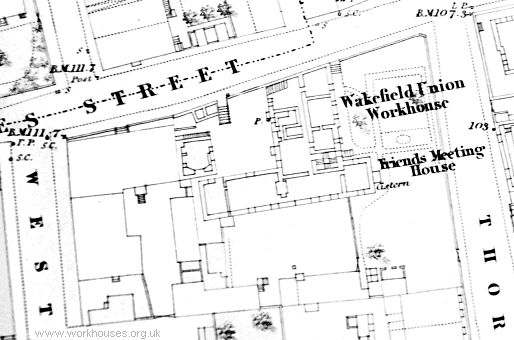
Wakefield George Street workhouse site, 1848.
A drawing of the building was made by Henry Clarke.
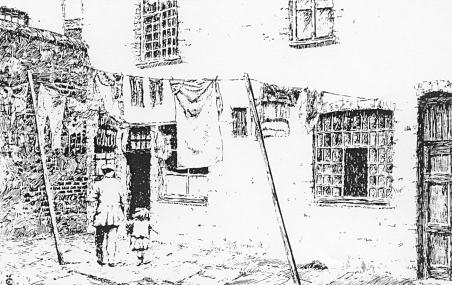
Wakefield George Street parish workhouse.
The George Street building was regularly condemned for its squalor. In 1851, when 103 inmates were in residence, the Wakefield Journal reported that:
Eventually, in 1851, a new union workhouse was erected at the south side of Park Lodge Lane. It was intended to accommodate 300 inmates at an estimated cost of £4,000. The new building was designed by JE Oates who was also the architect of workhouses at Blackburn and Sunderland.
The new Wakefield workhouse had a range of entrance buildings at the north containing the Master's offices, board room and committee rooms, and casual wards to each side. A central archway led through to the main T-shaped block which housed male inmates at the west and females at the east. The dining hall and kitchens were located in the rear wing. The workhouse site location and layout are shown on the 1905 map below.
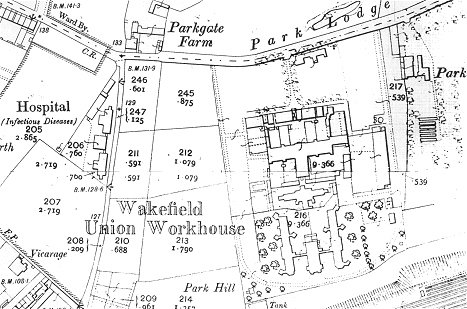
Wakefield workhouse site, 1905.
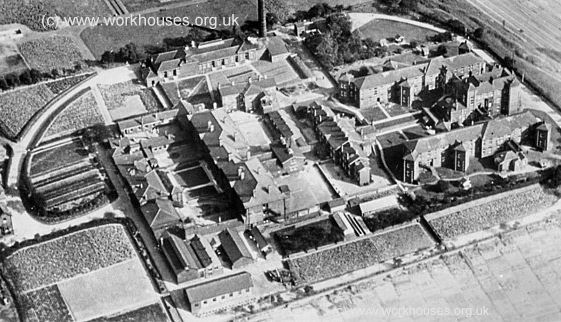
Wakefield aerial view from the west.
©Peter Higginbotham

Wakefield main building from the north, 1970s.
The original infirmary stood at the south of the workhouse and was enlarged in 1881.
In 1894, the British Medical Journal set up a "commission" to investigate conditions in provincial workhouses and their infirmaries. Following a visit to Wakefield, the commission's report found conditions to be generally of a good standard. The main concern was with the size of the nursing staff — two nurses (one in the main block and one a separate isolation block) provided the care for over 90 patients, spread across sixteen wards in each of which a pauper wardsman or woman acted as a nursing assitant. At night, a single trained nurse was on duty for the whole institution. The commission recommended that the nursing staff be at least doubled. Further details are available in the full report.
A large new pavilion-plan infirmary was erected to the south of the workhouse in 1896-8. It was designed by local architect William Watson. The new infirmary provided 150 beds and cost £20,000. It had the most up-to-date facilities of its time including filtered, washed and humidified air, electric lighting, and its own telephone system.

Wakefield new infirmary from the south, 1970s.
A new porter's lodge and receiving wards were added at the entrance to the site in 1904.
From 1904, to protect them from disadvantage in later life, the birth certificates for those born in the workhouse gave its address just as 90 Park Lodge Lane, Wakefield.
During the First World War, the infirmary provided 100 beds for military patients.
In 1930, the site came under the control of the West Riding County Council. A plan of the site layout at that time is shown below.
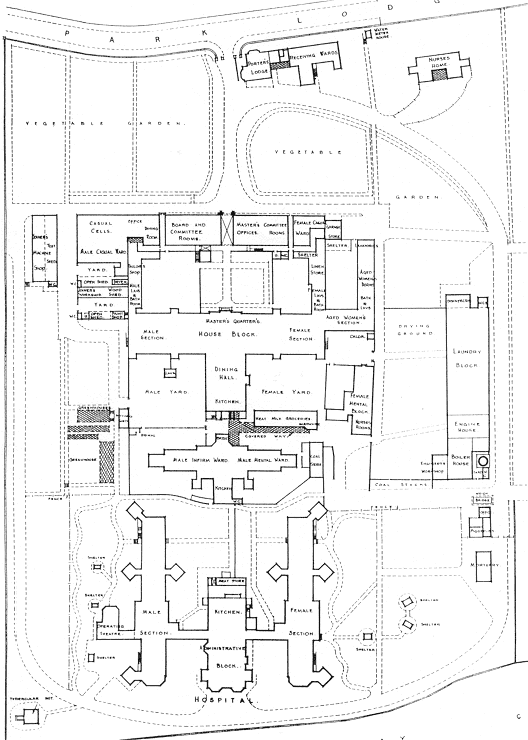
Wakefield site plan, 1930.
The workhouse later became known as Stanley View and provided accommodation mainly for the elderly, but also temporary homes for homeless families and battered wives. The infirmary part was developed as Wakefield County Hospital, becoming part of the National Health Service in 1948. After 1968, it too catered mainly for elderly patients.
All the workhouse buildings have now been demolished and the site is occupied by a housing estate.
Scattered Homes
From the early 1900s, pauper children were increasingly accommodated outside the workhouse in scattered homes. The homes' locations included:
- 'Heath View', 60 Regent Street, Wakefield
- 58 Teall Street, Wakefield
- 'Poplar Place', 143 Thornes Lane, Wakefield
- 26 College Grove Road, Wakefield
- 'Ash Grove', 57 Quebec Street, Wakefield
- 30 Garden Street, Wakefield
Another of the homes, 'Stoneville', at 112 York Street, was sometimes listed separately as a 'Children's Home' so may have been a headquarters home, acting as an administrative centre and dealing with new arrivals.
Staff
Inmates
Records
Note: many repositories impose a closure period of up to 100 years for records identifying individuals. Before travelling a long distance, always check that the records you want to consult will be available.
- West Yorkshire Archive Service (Wakefield Office), West Yorkshire History Centre, 127 Kirkgate, Wakefield WF1 1JG. Very few local records survive — holdings include Guardians' minute books (1897-1930). The recently acquired John Goodchild Collection has added: Register of deaths (May 1933 - Jul 1937) and Register of Admissions (1885-1910).
Bibliography
Links
- Ripon Workhouse Museum and Garden, Sharow View, Allhallowgate, Ripon HG4 1LE.
- BMJ Report on Wakefield Workhouse and Infirmary, 1894
Unless otherwise indicated, this page () is copyright Peter Higginbotham. Contents may not be reproduced without permission.


